Shhh! I am going to
divulge the secrets to flawless interior design. Well, they’re not
exactly secrets. In fact, they’re part of every interior design
curriculum. They’re called the seven principles of interior design. A
combination of these key principles are present in all well-designed
interior spaces.
If you incorporate each
of the principles to your home’s design scheme, you can create a
beautiful interior that rivals that of the professionals. Let’s get
started!
Unity
Unity,
continuity and harmony are necessary to link all interior spaces. Using
a variety of disparate styles throughout a home results in visual
interruptions as you travel from one area to another. Each of your
interior spaces should work together to create a unified whole.
Use similar design
elements to unify your decorating scheme. For instance, painting each
room a different color can be jarring. However, if you unify the spaces
by using a limited palette of complimentary colors, you will create
visual flow and harmony.
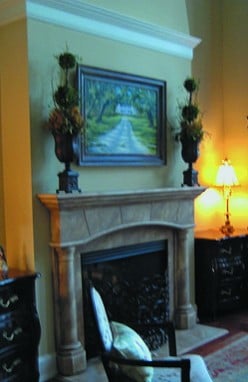
Symmetrical balance is very pleasing to the eye.
Balance
Balance
in interior design refers to the proper distribution of objects in a
room to create visual balance. There are three ways to create balance in
a room:
Using symmetrical balance
is the most common way to accomplish visual equilibrium. To create
symmetrical balance on a mantel, place one large object in the center
(like a painting) and place matching objects on either side of the
mirror. This is a simplistic example, but it illustrates perfect
balance.
When employing asymmetrical balance
in your home, you will create a more relaxed feel. Let’s use the mantel
example again. Instead of matching candlesticks, you can substitute
dissimilar objects with similar dimensions to maintain that even
distribution of visual weight. Although it takes a bit more effort to
achieve, asymmetry will give your room a more casual appearance.
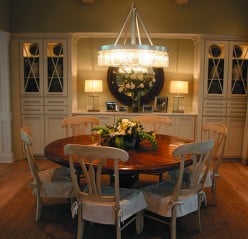
A round dining table is a good example of using radial balance in a room.
Radial balance is the arrangement of objects around and radiating out from a larger central object. The most familiar example of radial balance is a table positioned in the center of a dining room. The placement chairs and other furnishings in the room are based on the table as a central focal point.
Rhythm
Rhythm,
in music and interior design, are similar in nature. Consider the
rhythmic beat of a song and repetitive design elements in a room. Your
foot taps to the beat and your eye bounces about a room to take in the
design elements. Bring a sense of rhythm and movement to your rooms with
color, shape, size, texture or pattern through repetition, progression,
transition.

Repeating one color throughout a room creates rhythm.
Repetition is extremely easy to accomplish, just do so with a light hand. Using pops of orange throughout a room will do the trick. However, be aware that too much repetition in a room can be as annoying as listening to the same techno track all day, every day!
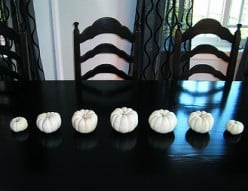
This pumpkin centerpiece is a perfect example of progression.
Progression is achieved by using a group of like objects that vary in size. A collection of seashells, candles or even pumpkins, ranging from small to large, are all examples of progression.
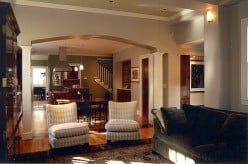
This arch transitions one space into another.
Transition is a bit more difficult to describe. It helps guide the eye gently and smoothly from one object or room to another. Arched doorways, windows and curvaceous furniture are the most common transitional tools in interior design.
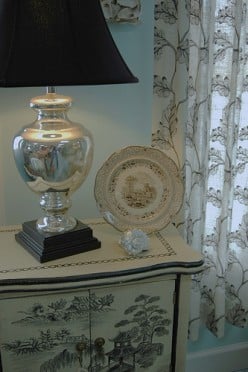
The use of black and white in a room creates a pleasing contrast.
Contrast
Contrast in a room can refer to color, form and use of space. As with repetition, a little contrast goes a long way.
One of my favorite ways to create contrast is through color. Nothing creates visual impact quite like using black and white in a room.
Another effective way
to add contrast is with form, such as the use of a large round mirror
above a sofa, a round side table and two square ottomans used as a
coffee table. This gives you a contrast of circles and squares.
Contrast also involves
positive and negative space in a room. Just as you have areas of
positive visual activity, you should also include areas of empty
(negative) space to create a contrast in volume. Keep this in mind when
arranging the contents of a room.
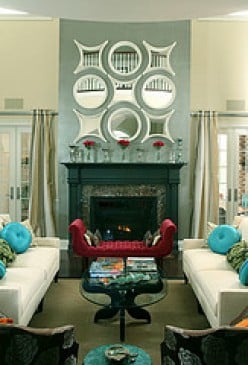
The fireplace and mirror collection exemplifies emphasis in a room.
Emphasis
Emphasis
is something we all know about. It simply means that every room or
space has a focal point, whether it is architectural or an object. A
fireplace is the most common architectural focal point. Oversized
artwork or a large piece of furniture can also be a focal point in a
room.
Interior design
elements like color, texture and form are used to add emphasis to a
focal point. If you refaced your fireplace with bronze glass tiles, you
have used color and texture to create emphasis.
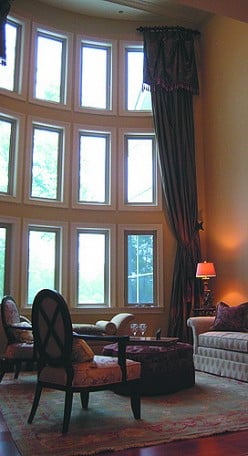
Tall furniture pieces would improve the scale of this room.
Scale and Proportion
Have
you ever been in a large room in which the furniture feels dwarfed by
the space; or a small room where the furniture overpowers the space? If
so, you understand the importance of scale. Scale relates to the size of
objects within a space.
Proportion, on the
other hand, refers to the size of one object to another. For instance,
you have a large, overstuffed chair and next to it, you place a
diminutive side table. The proportions of the items are all wrong. A
dainty slipper chair with the side table makes much more visual sense.

Don't forget about the details, like trim on pillows.
Details
Details
in interior design go far beyond the accessories in a room. Think of
the details as decorations on a cake. They are the small, subtle touches
that can make a huge impact in a room. Things like trim on a pillow, a
crystal lamp finial or decorative switch plate and outlet covers add
little touches of personality to your home that bring your design scheme
full circle!

No comments:
Post a Comment